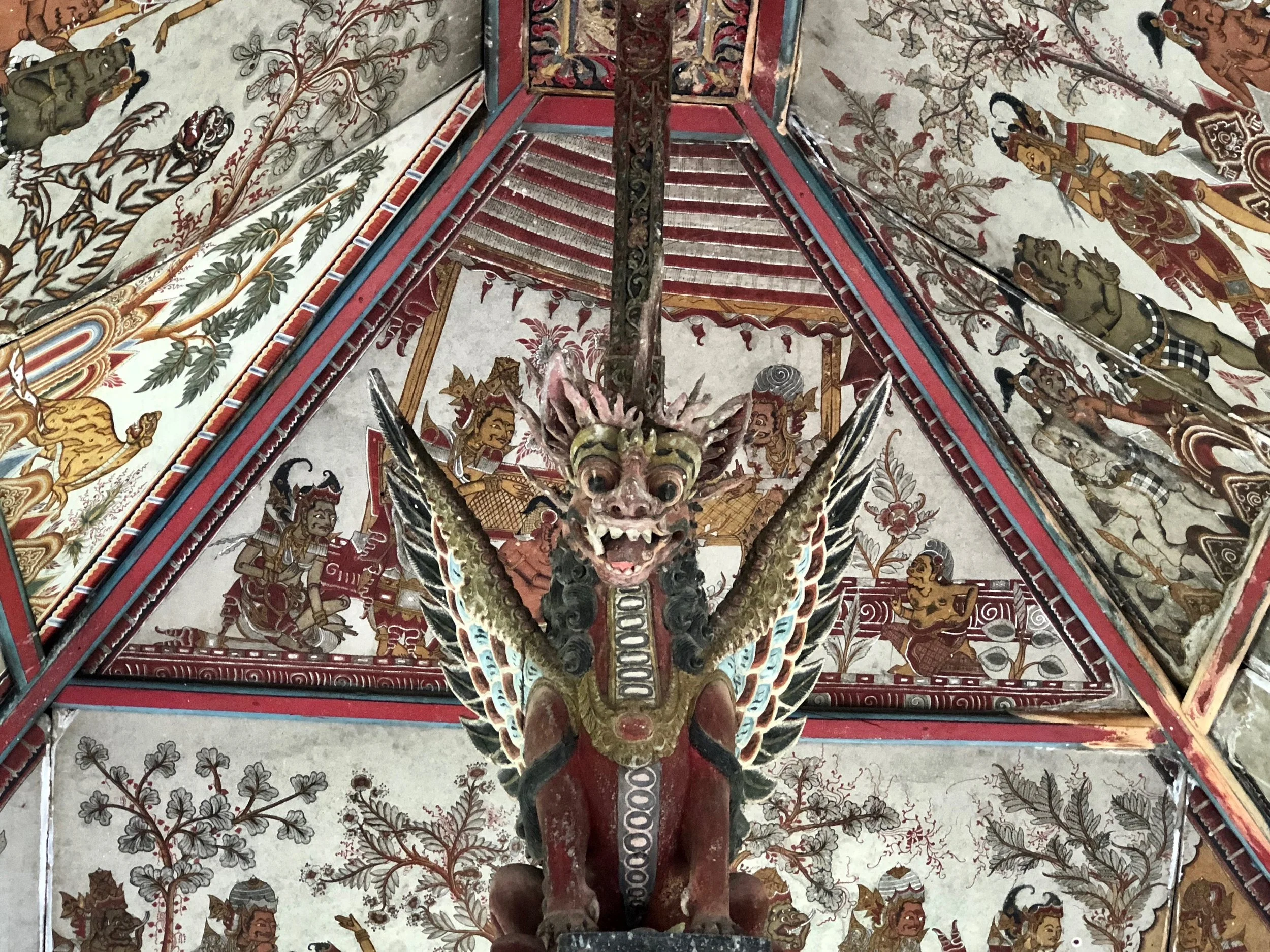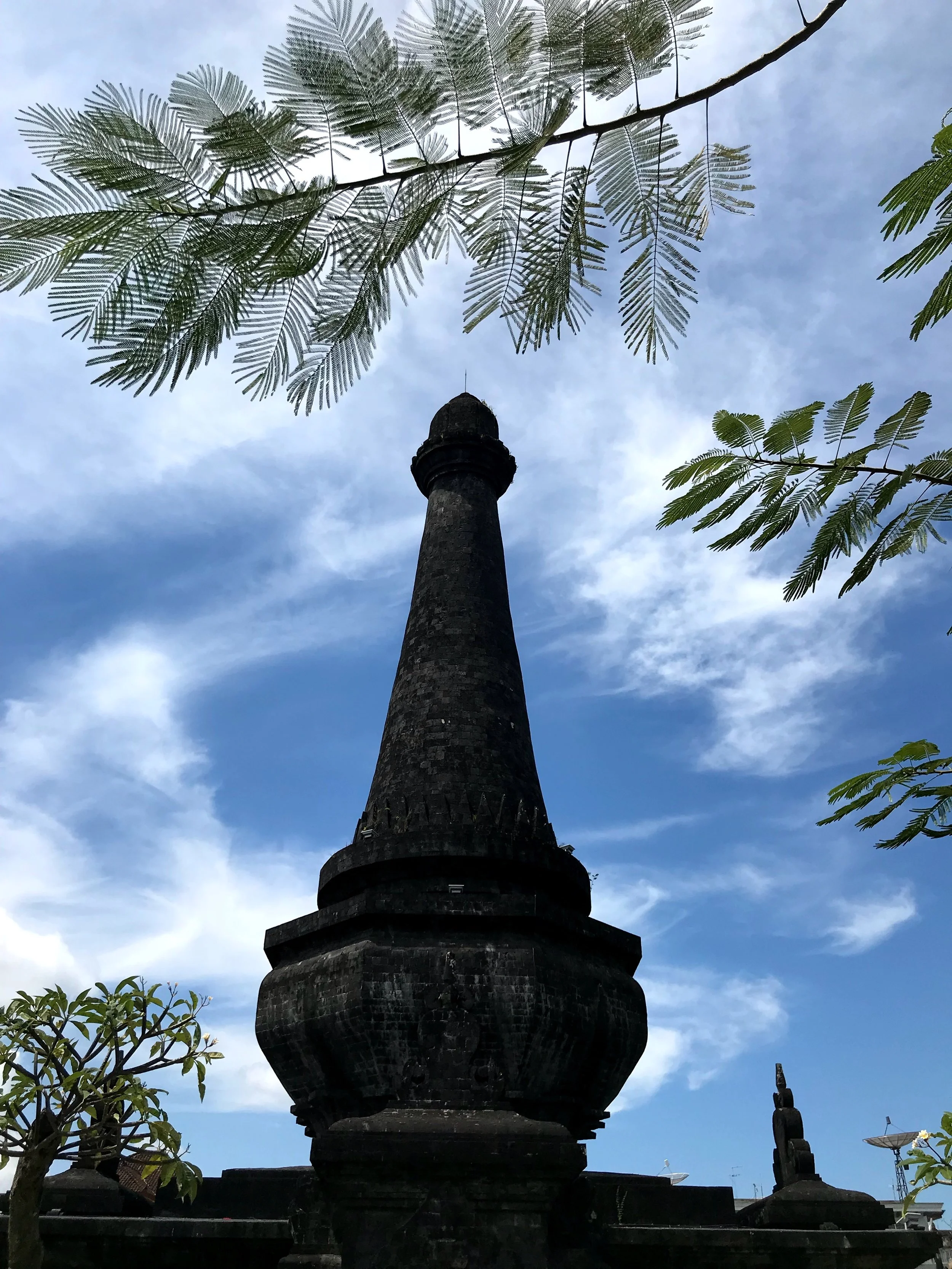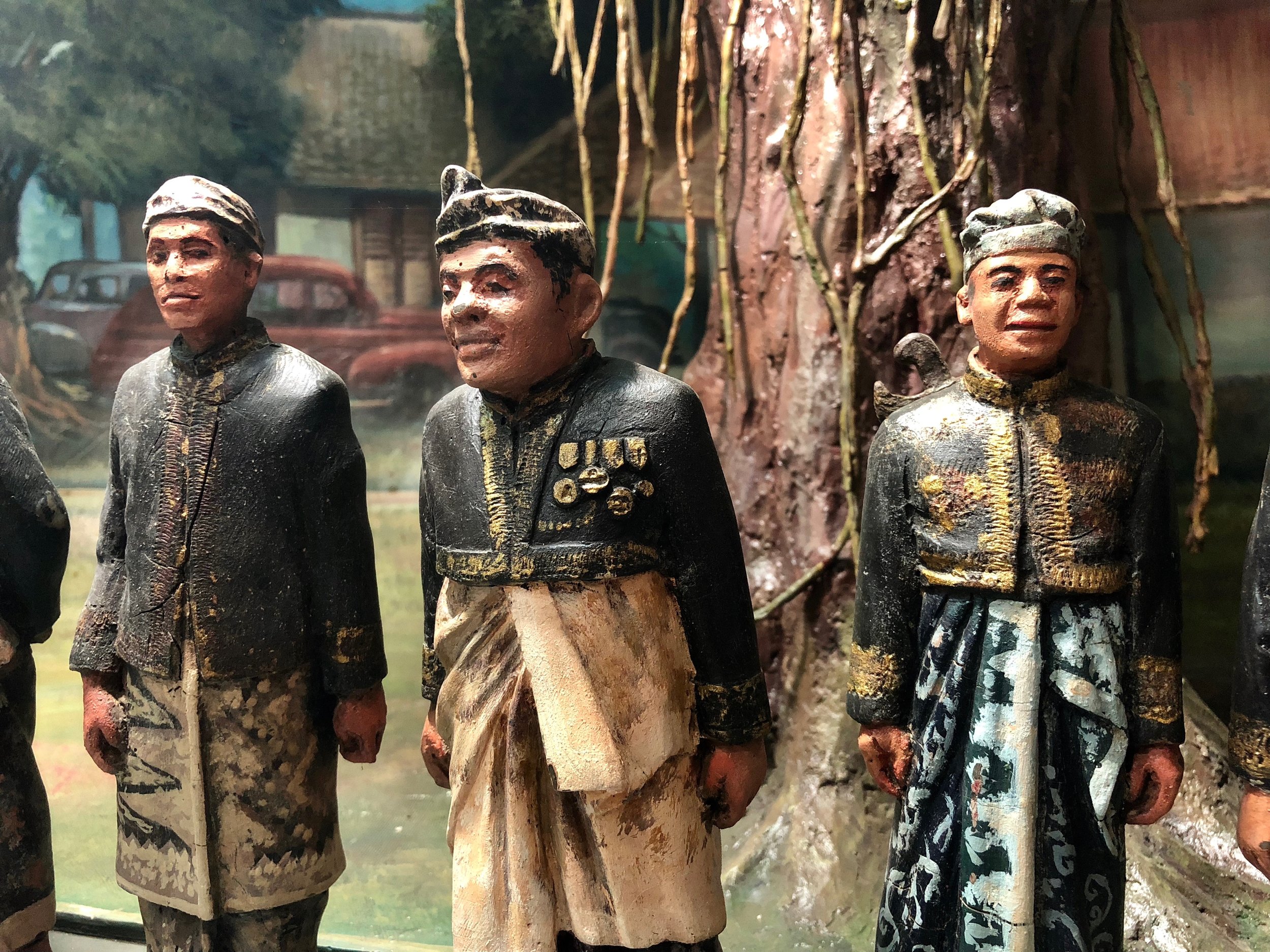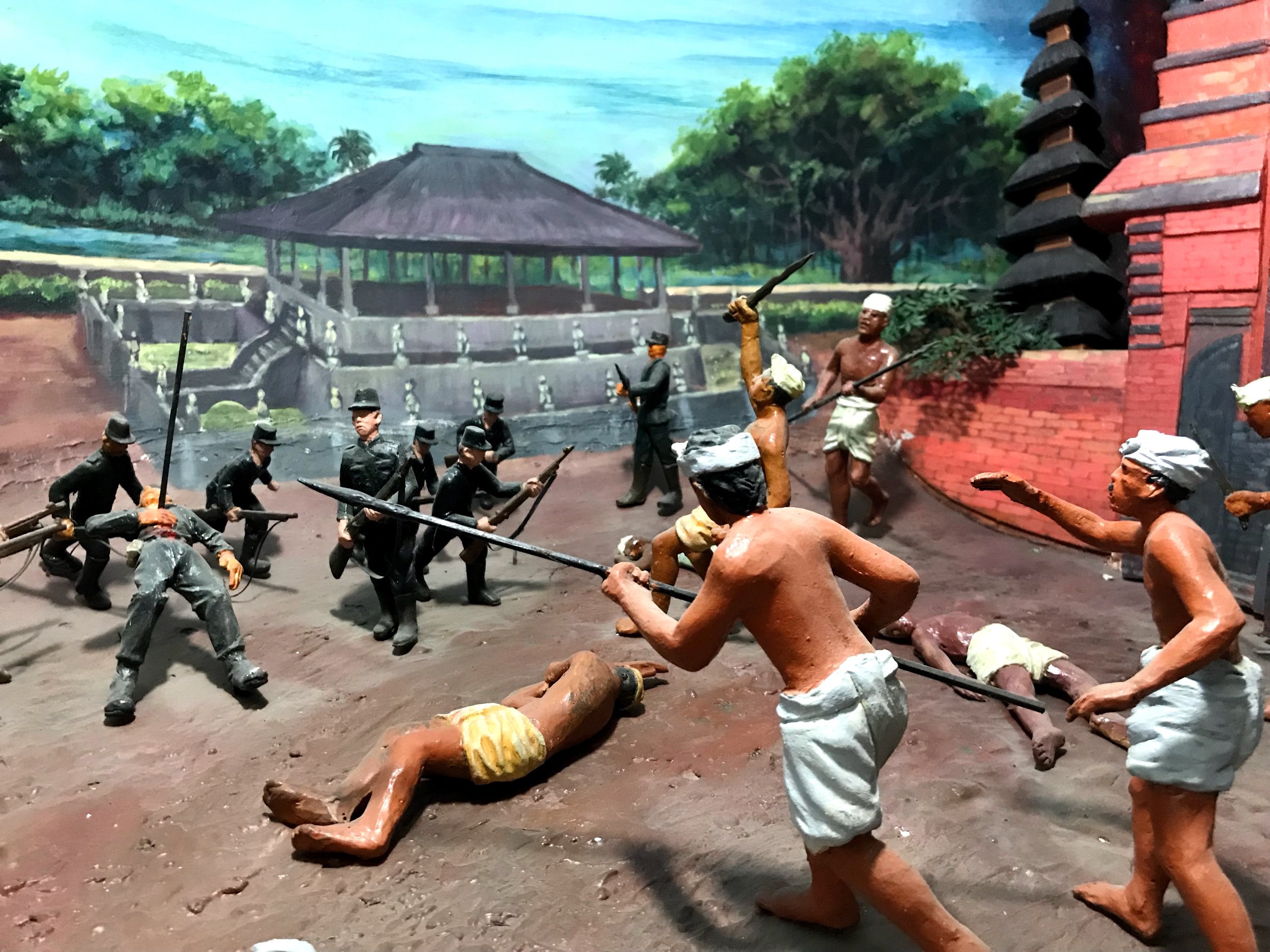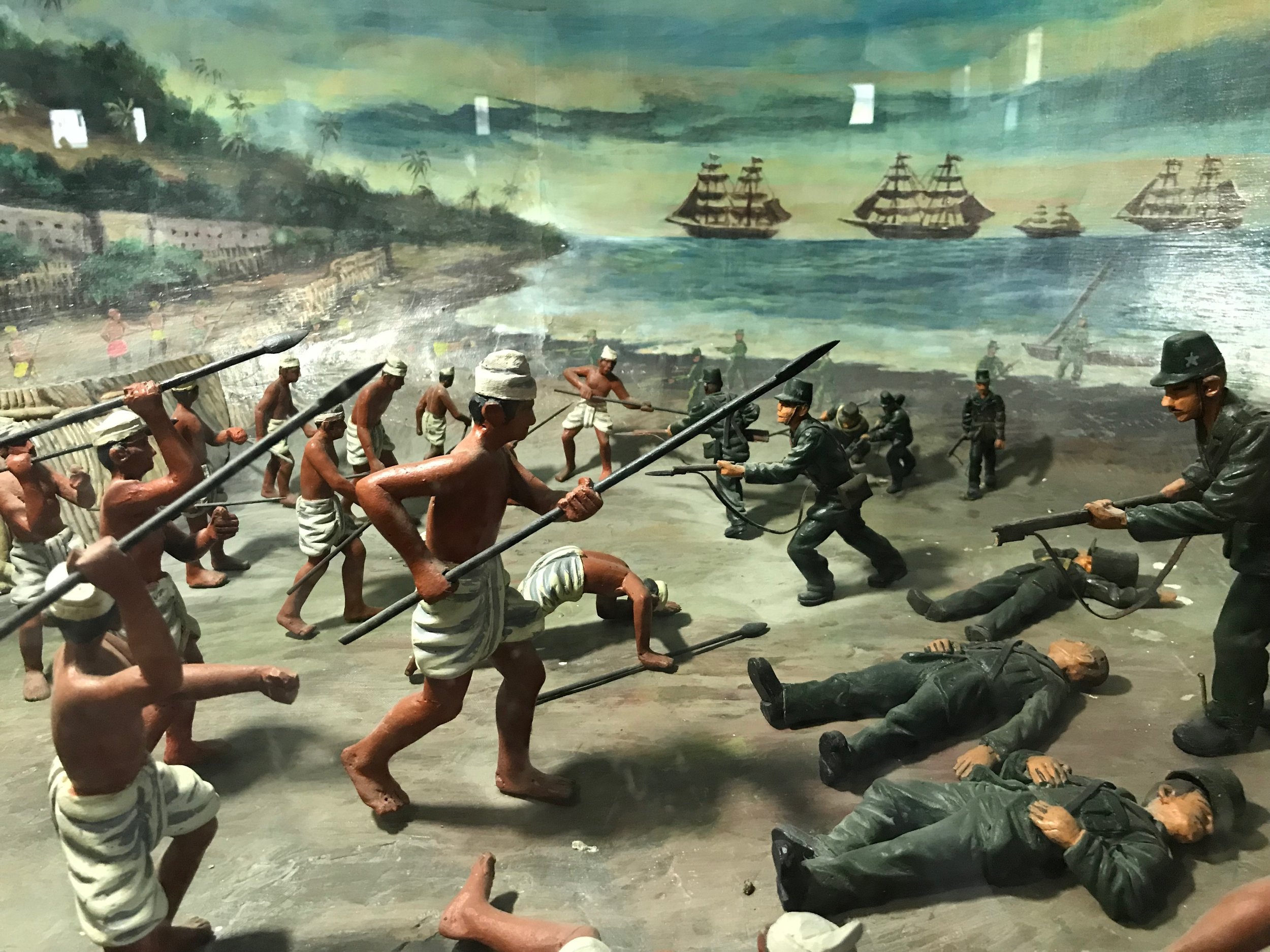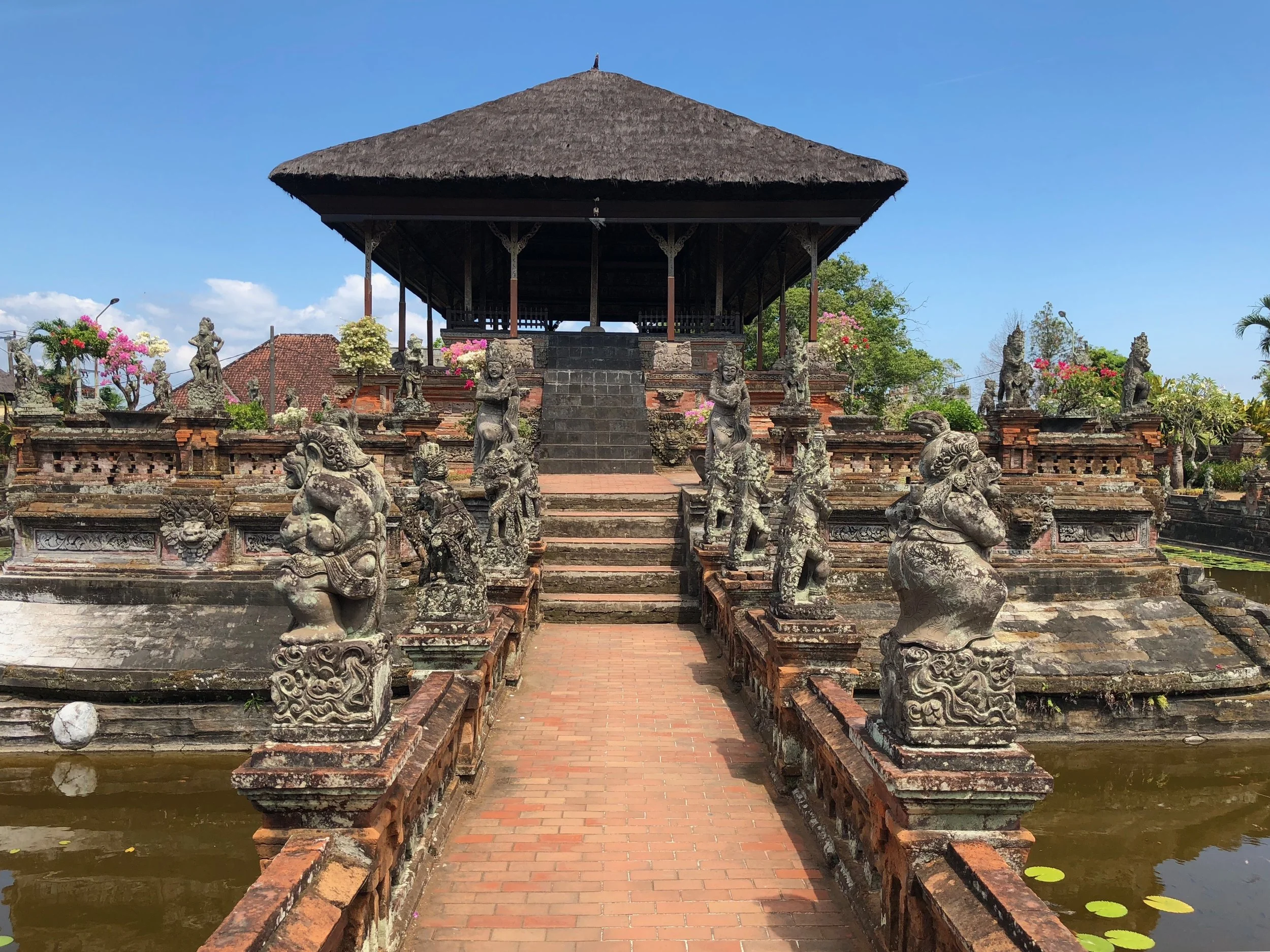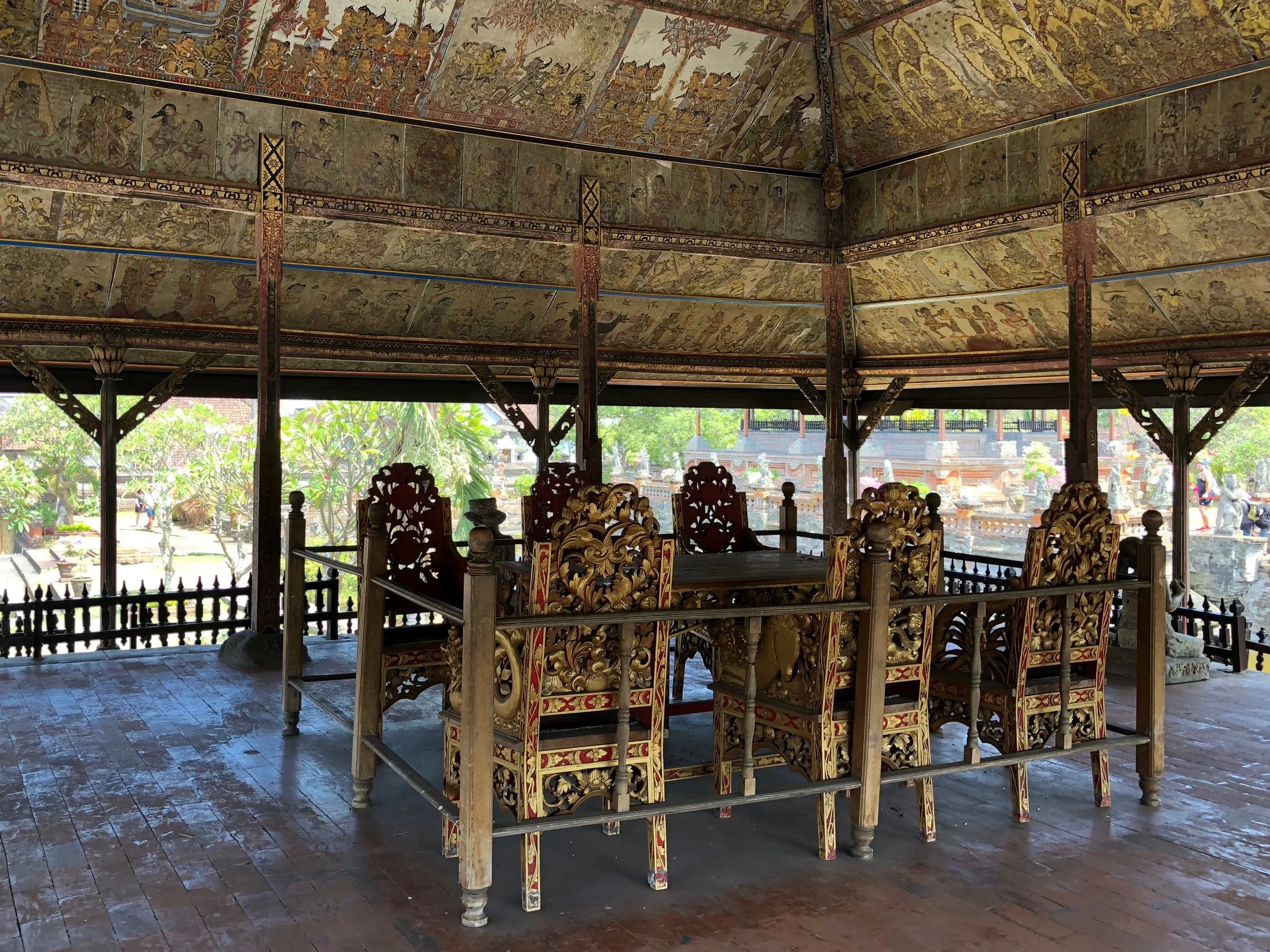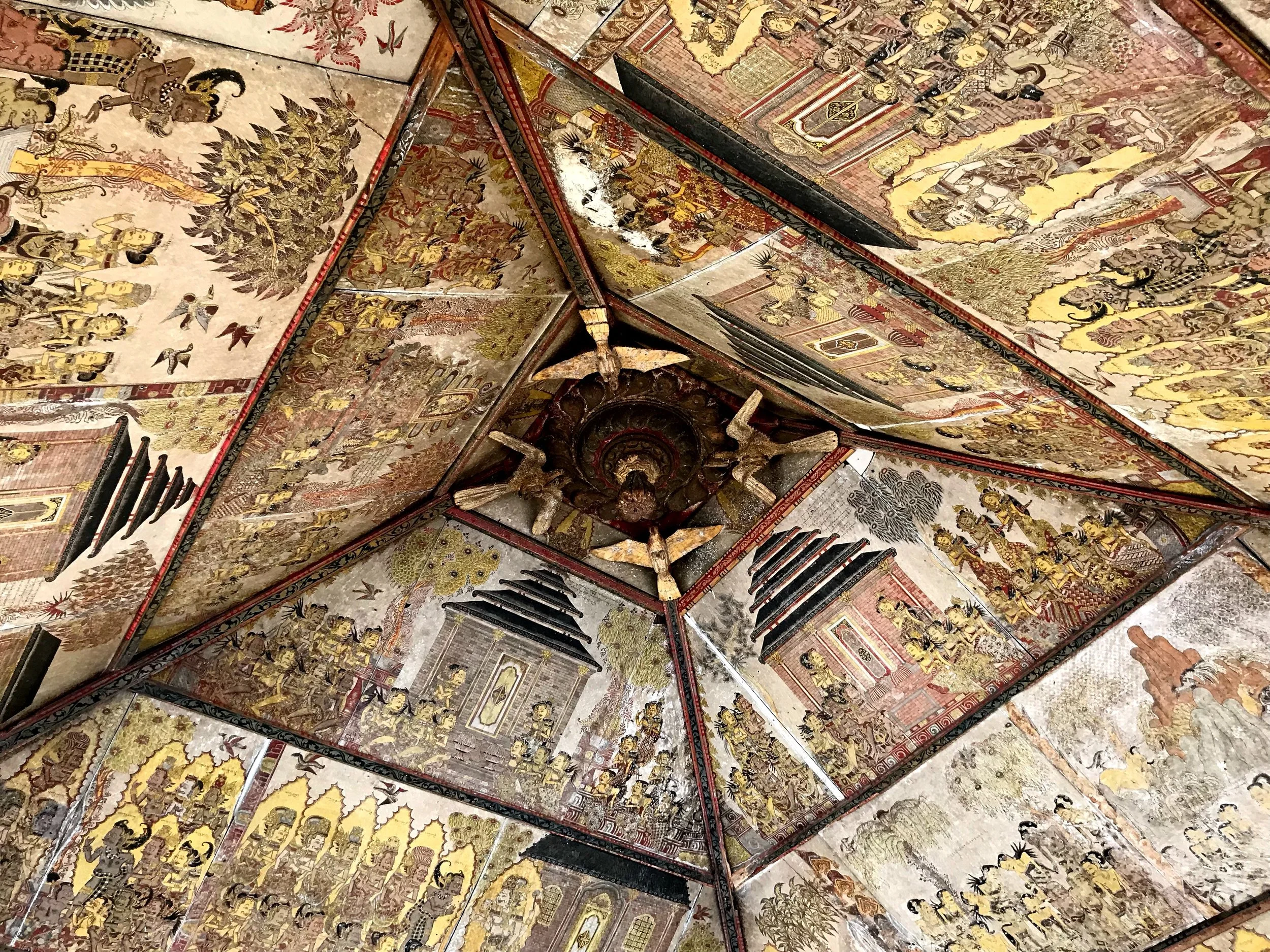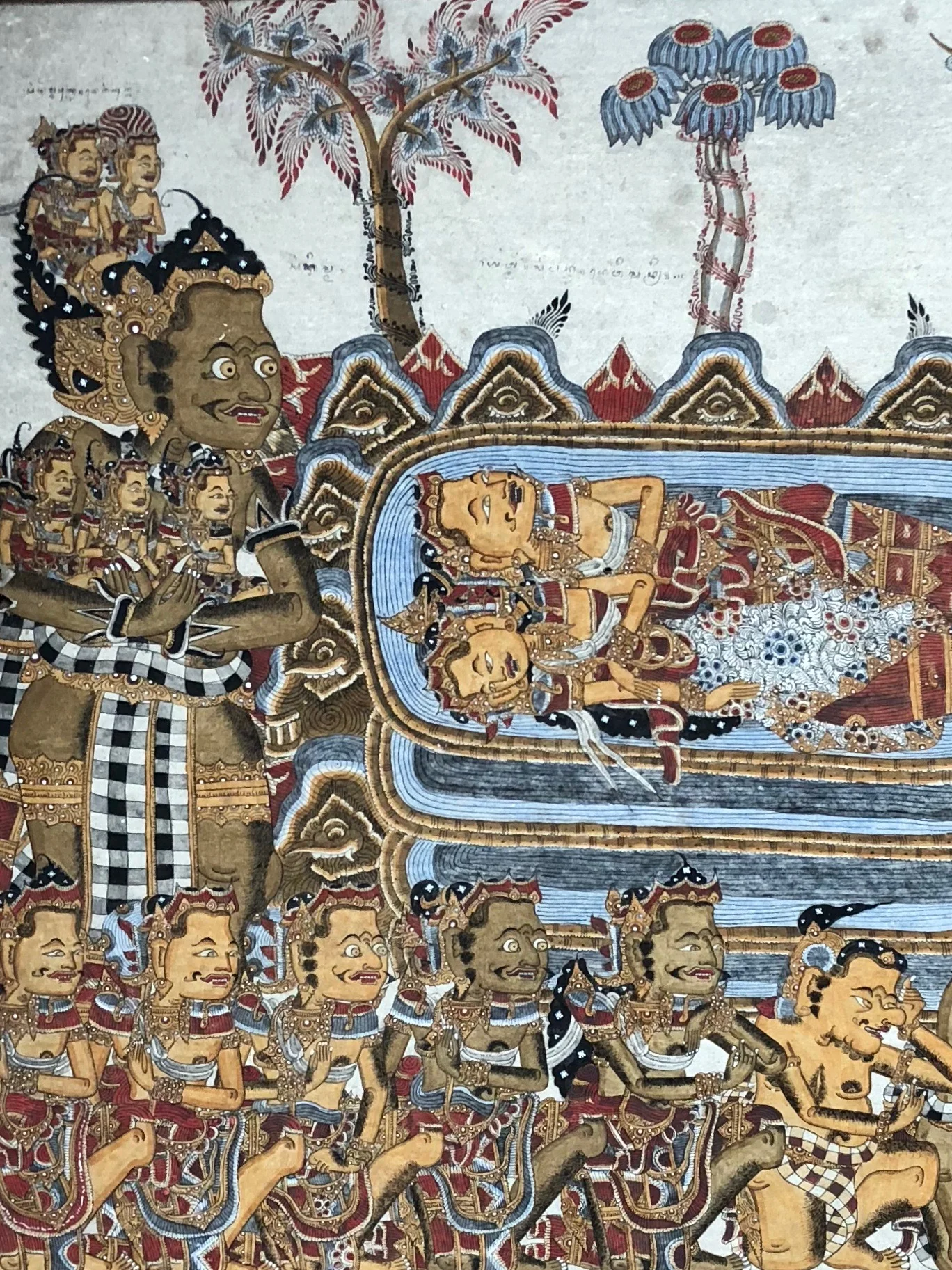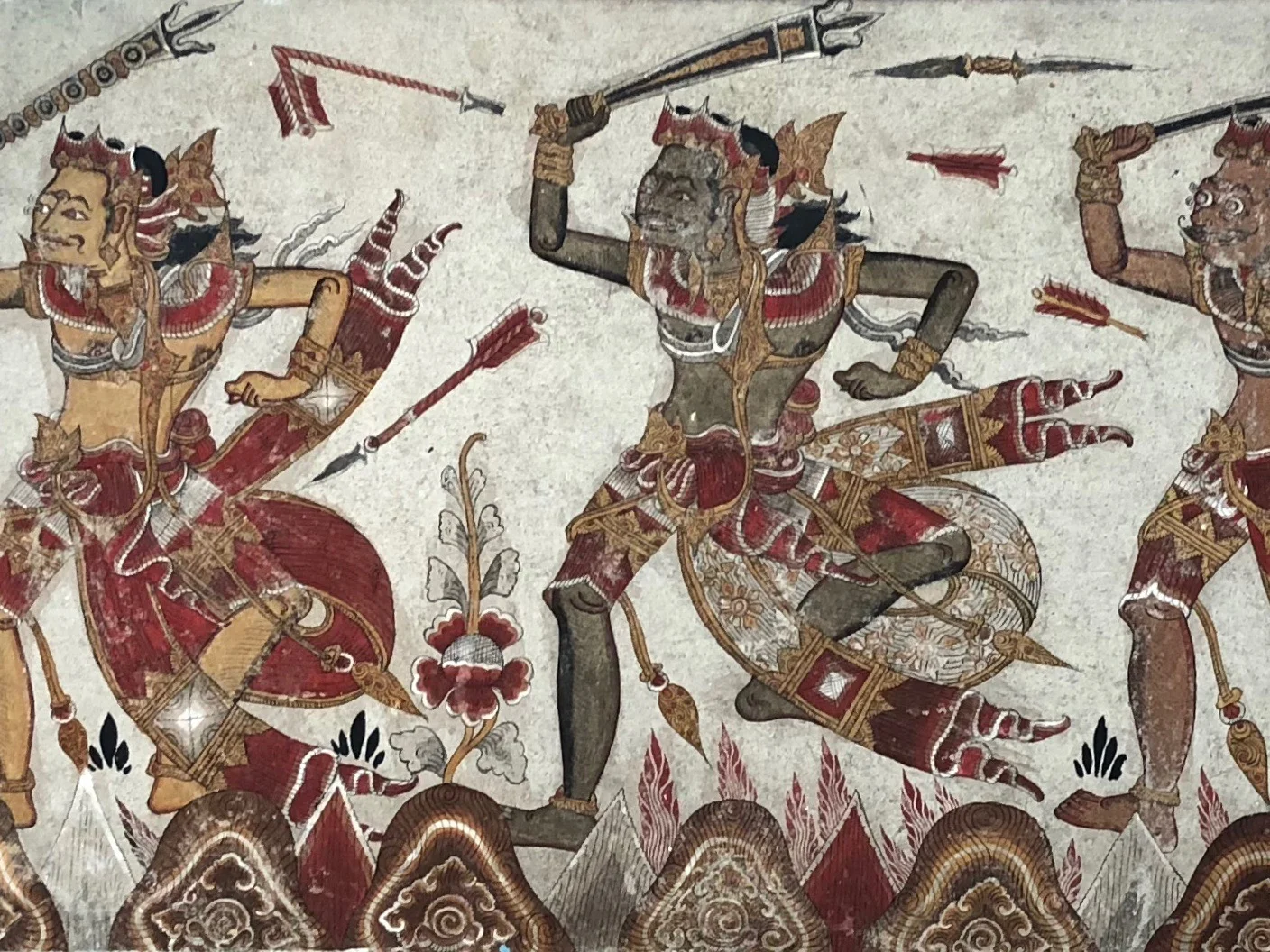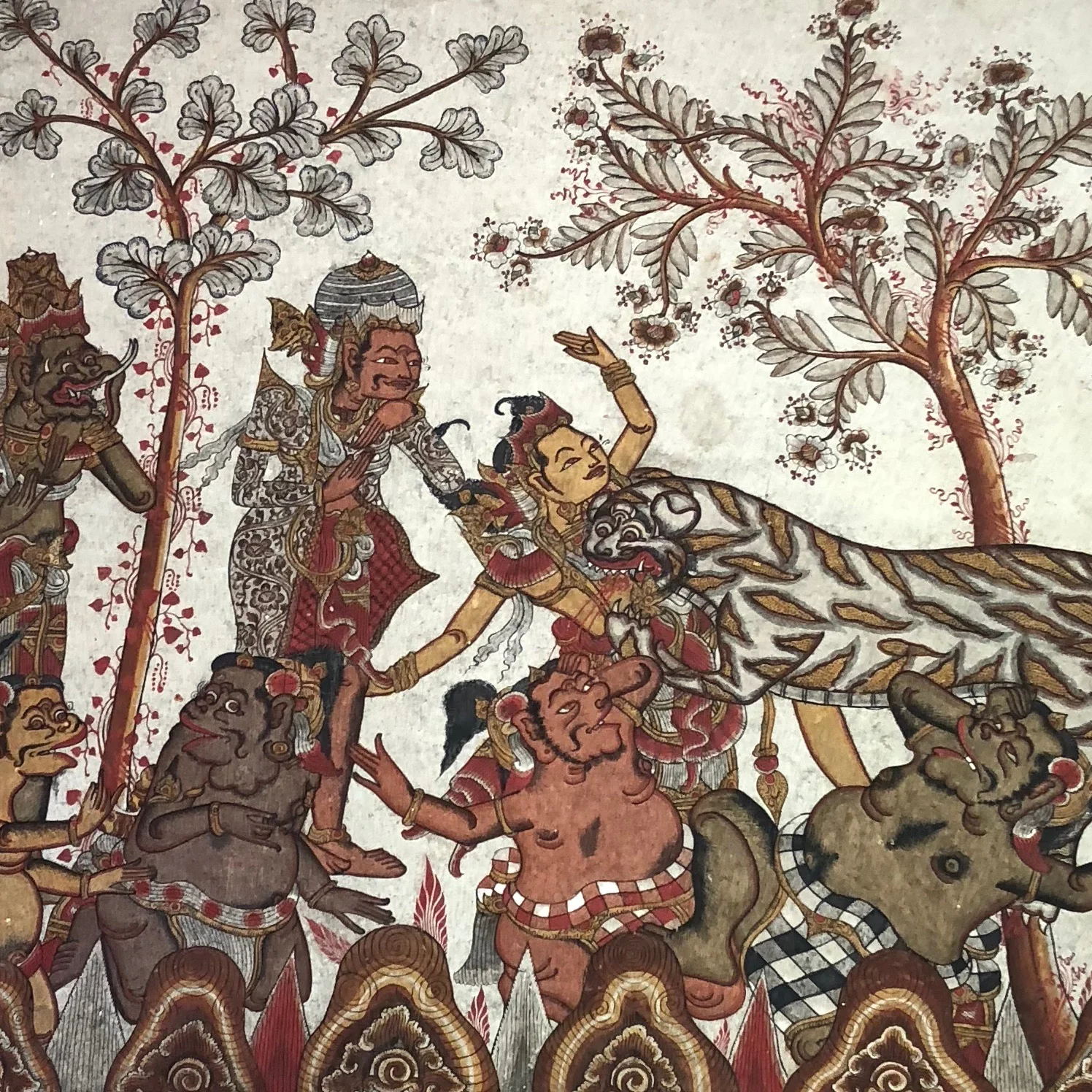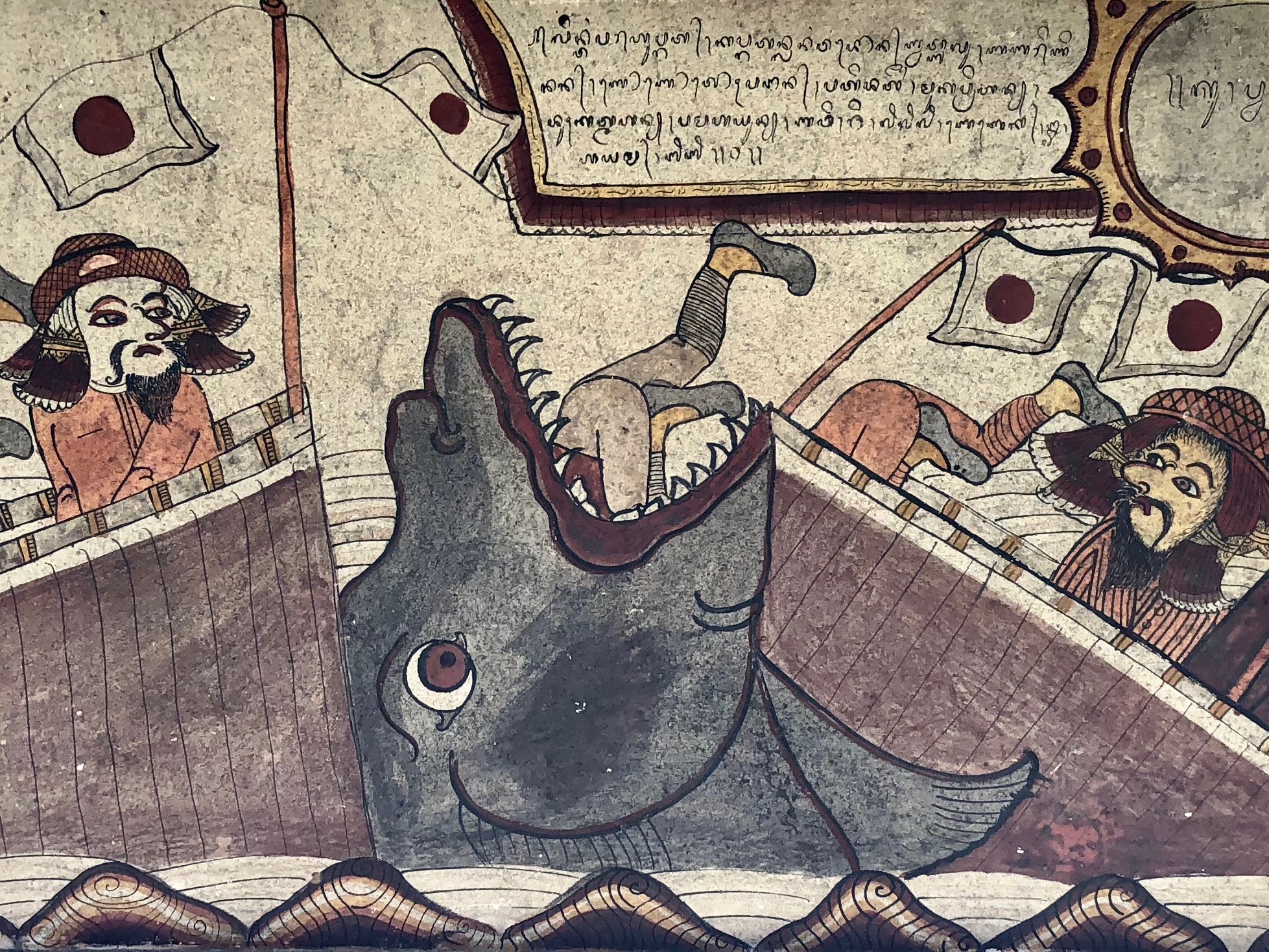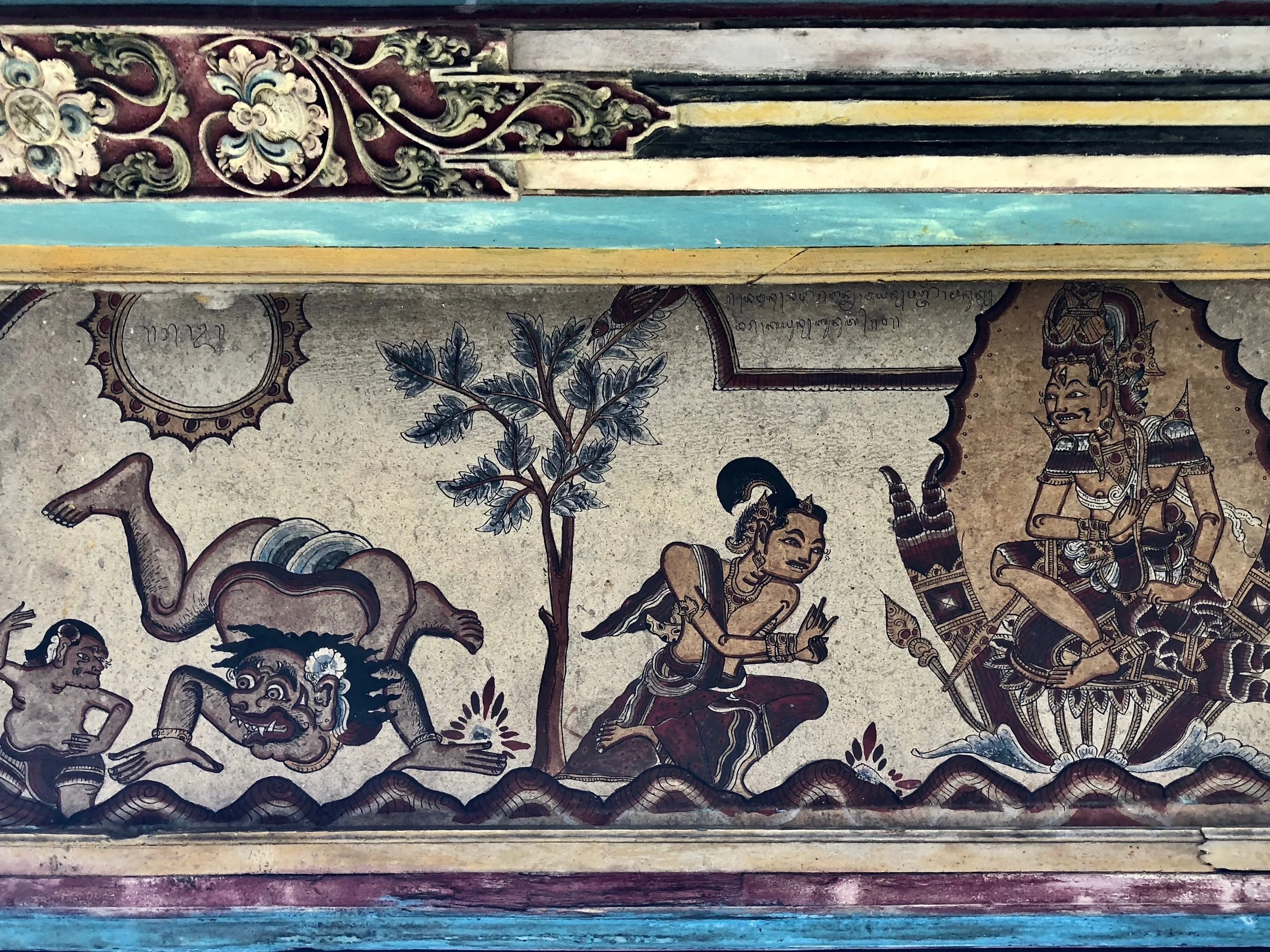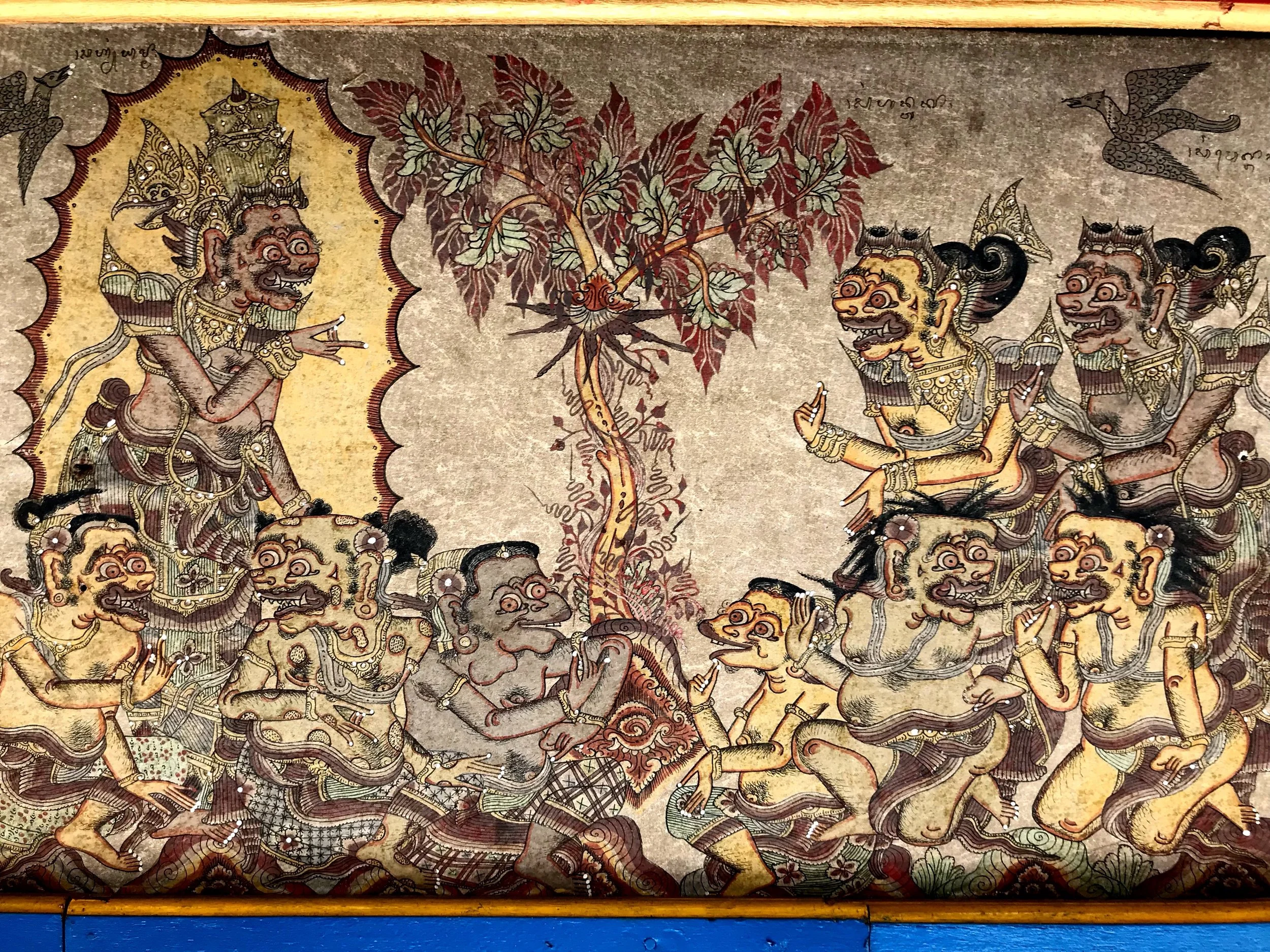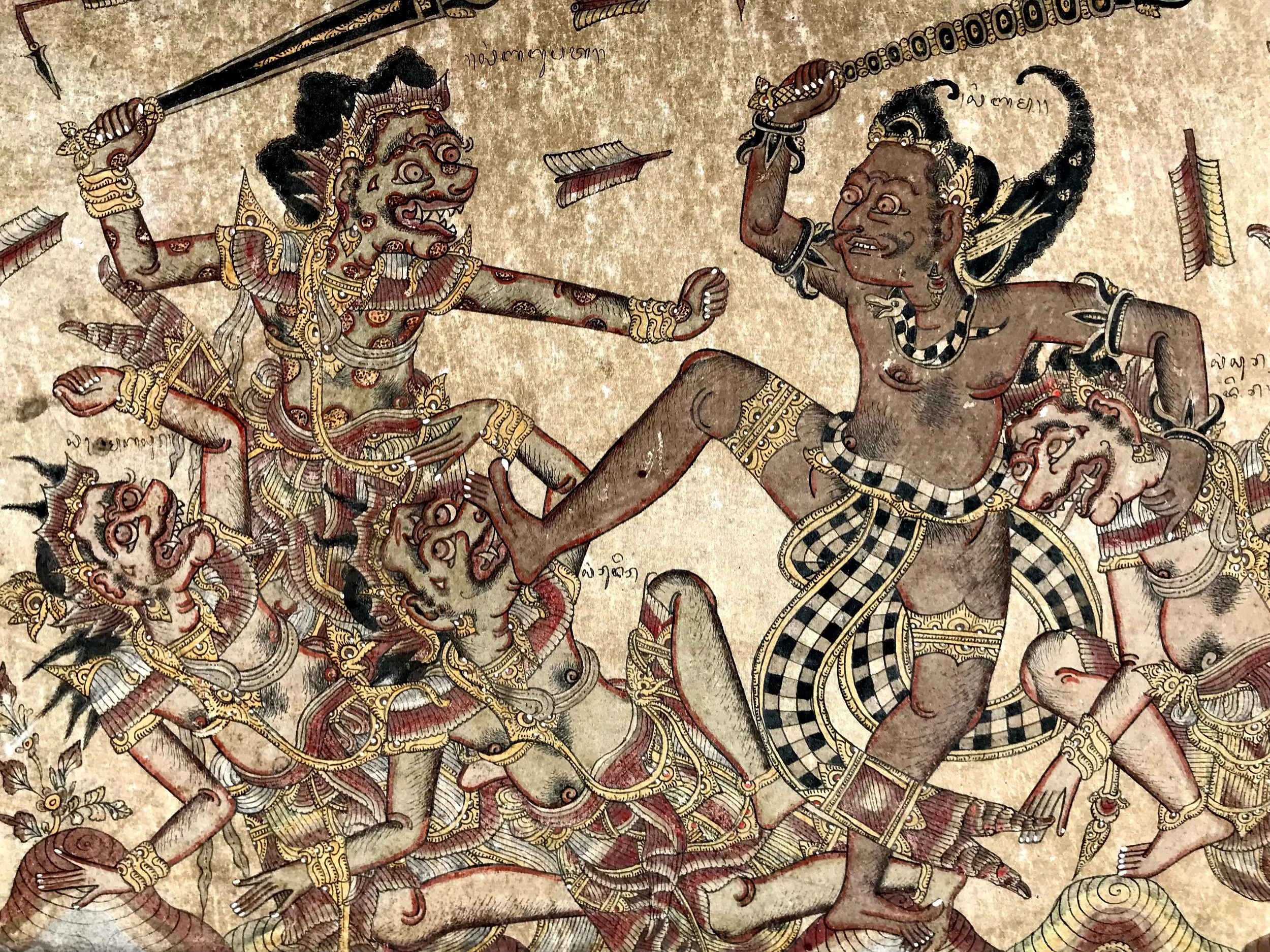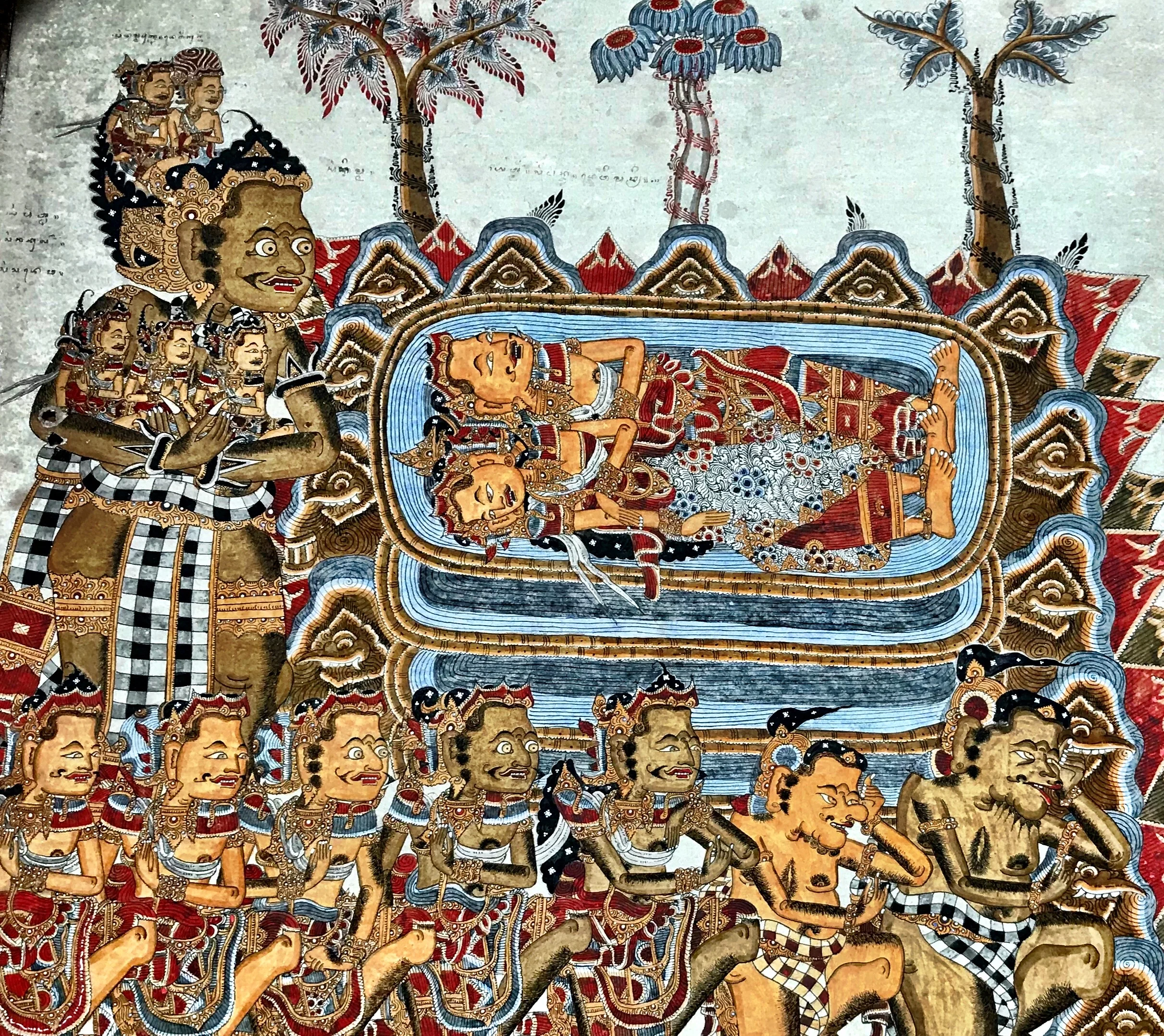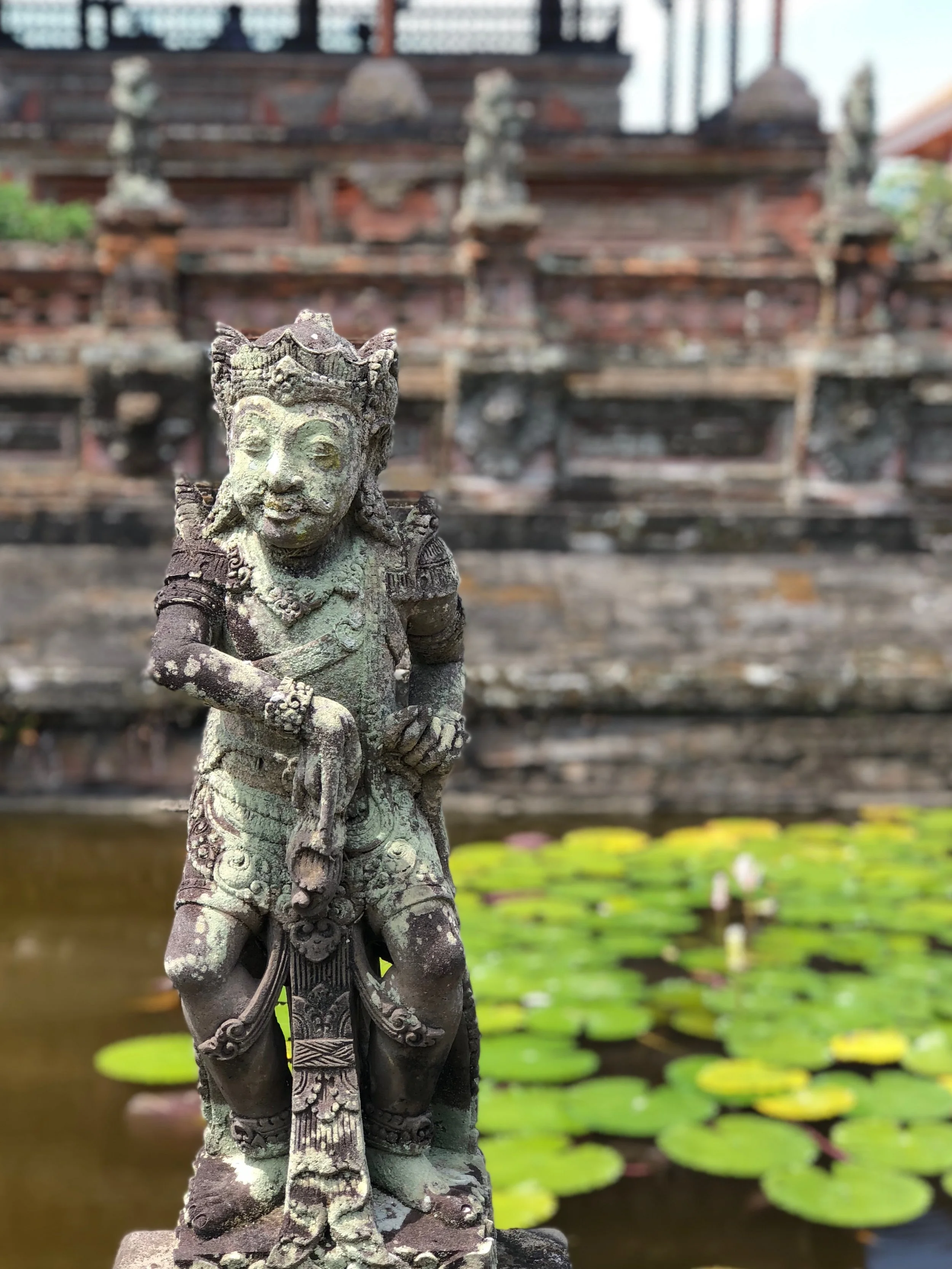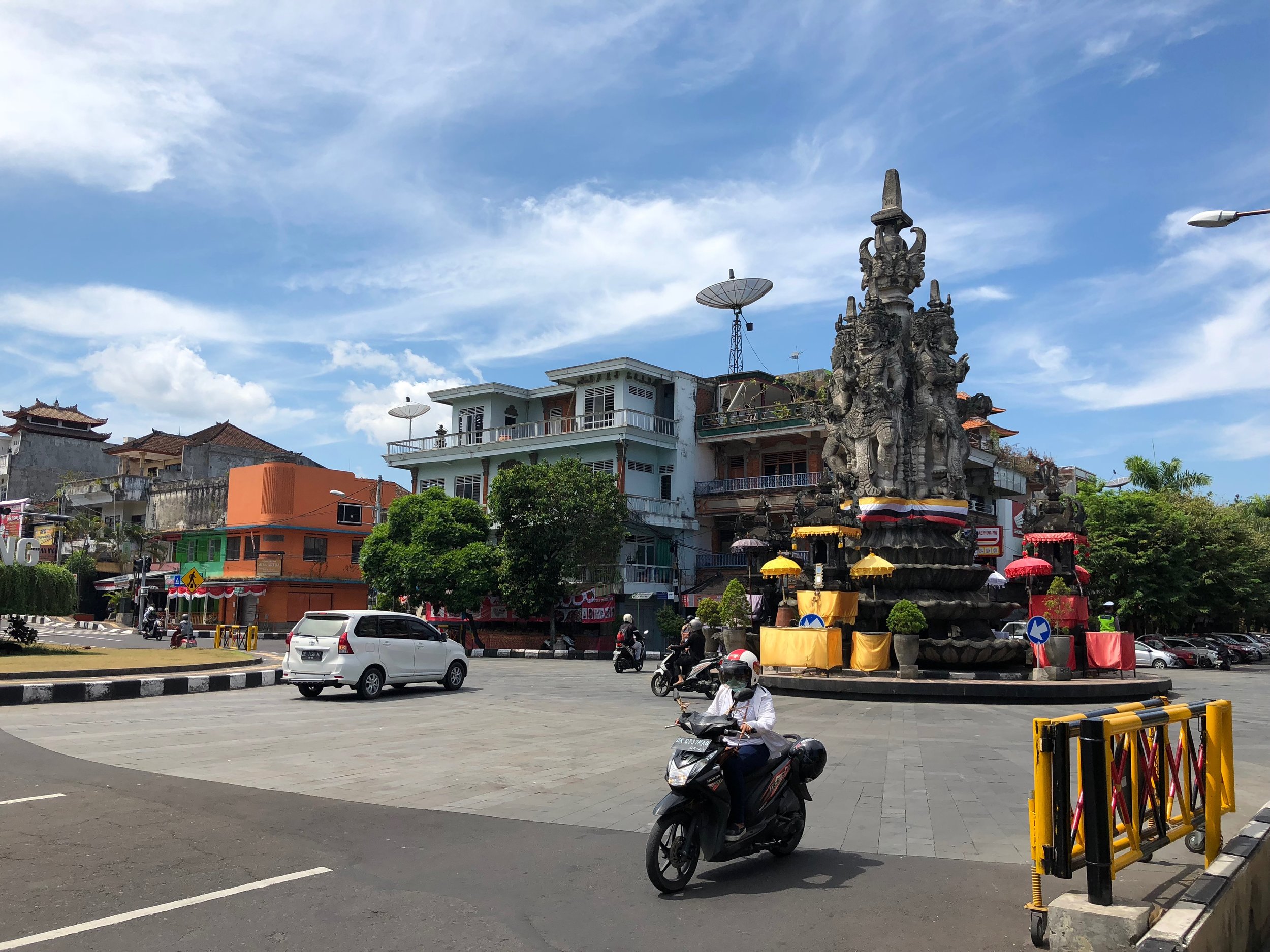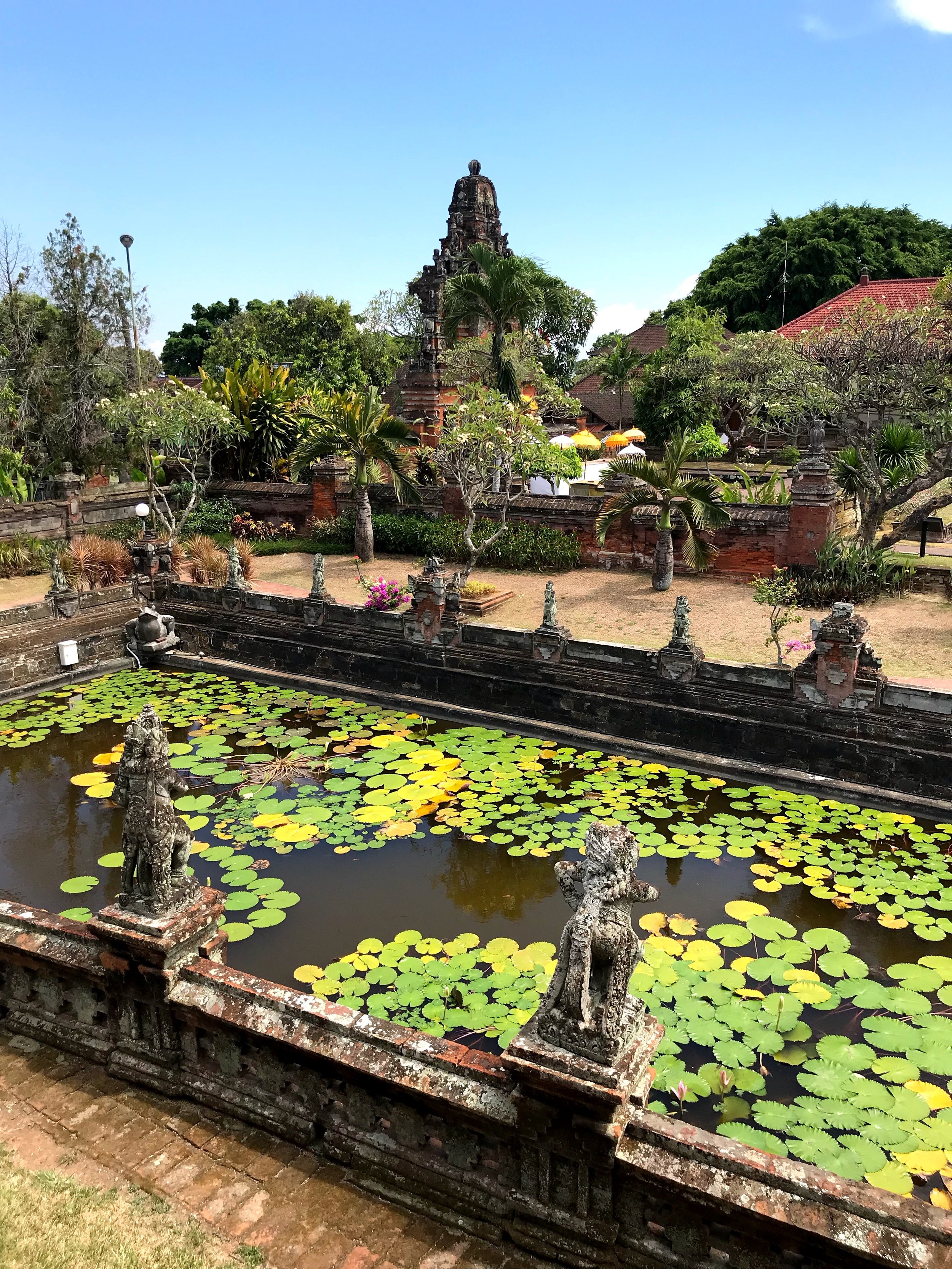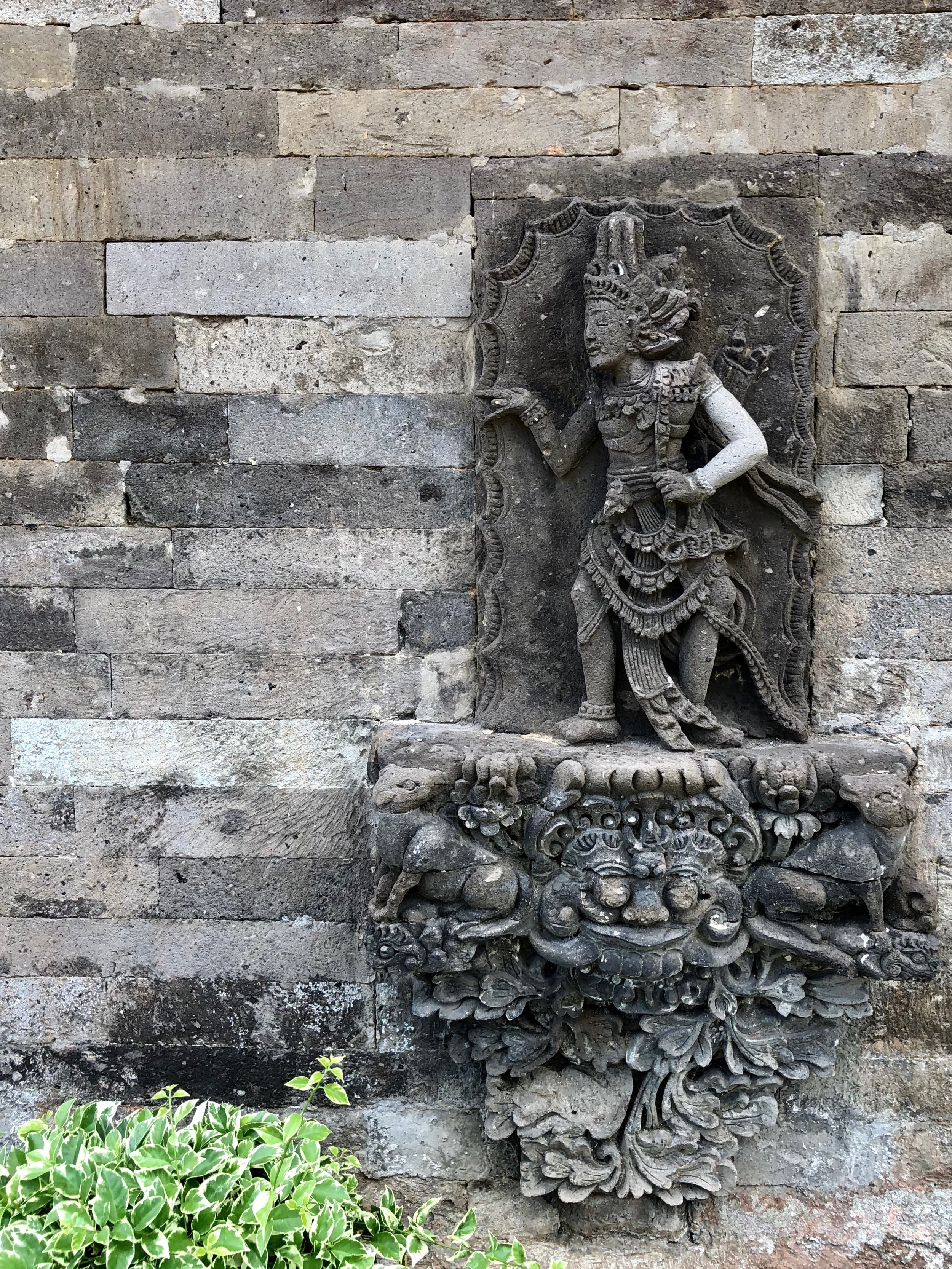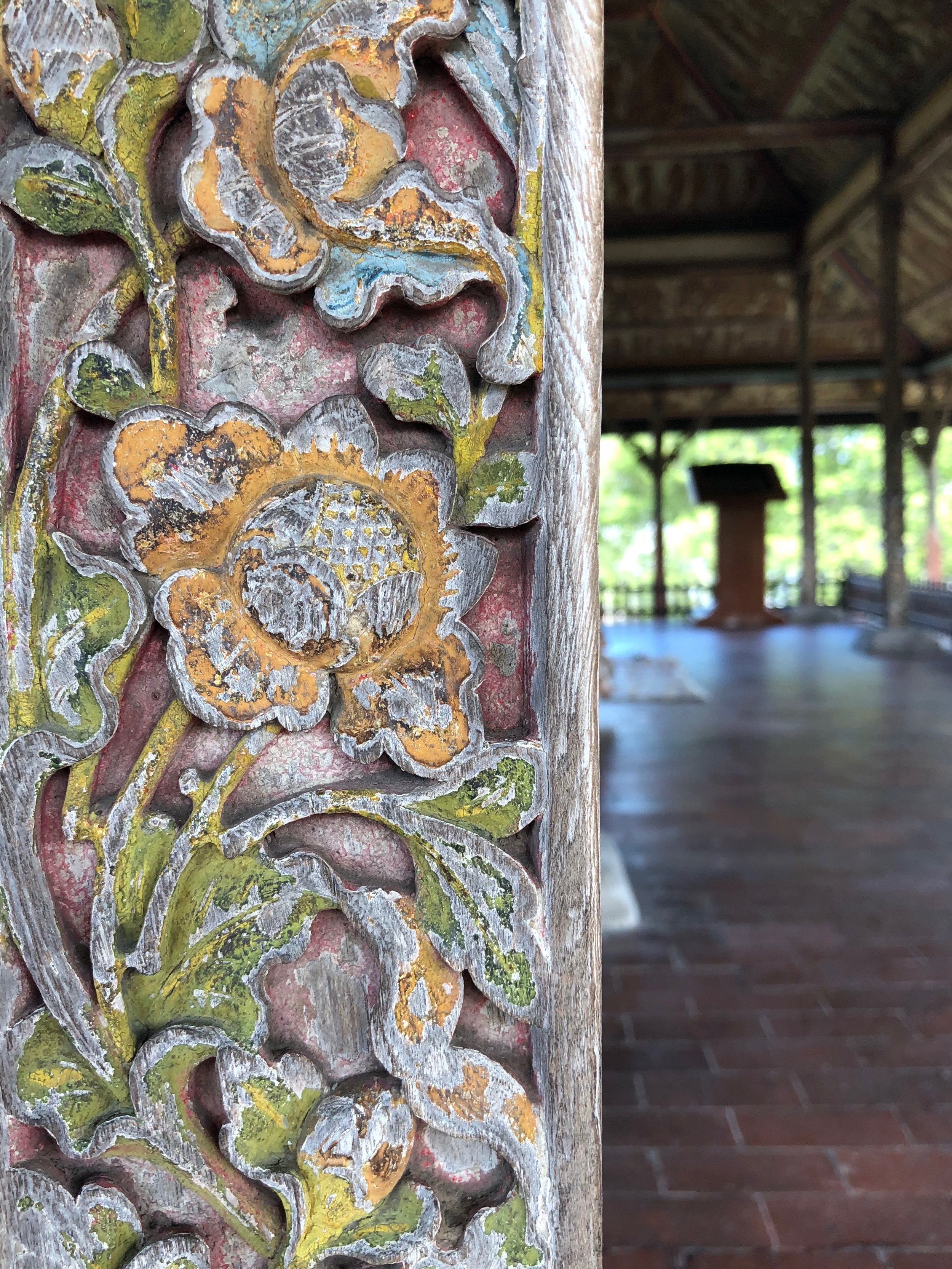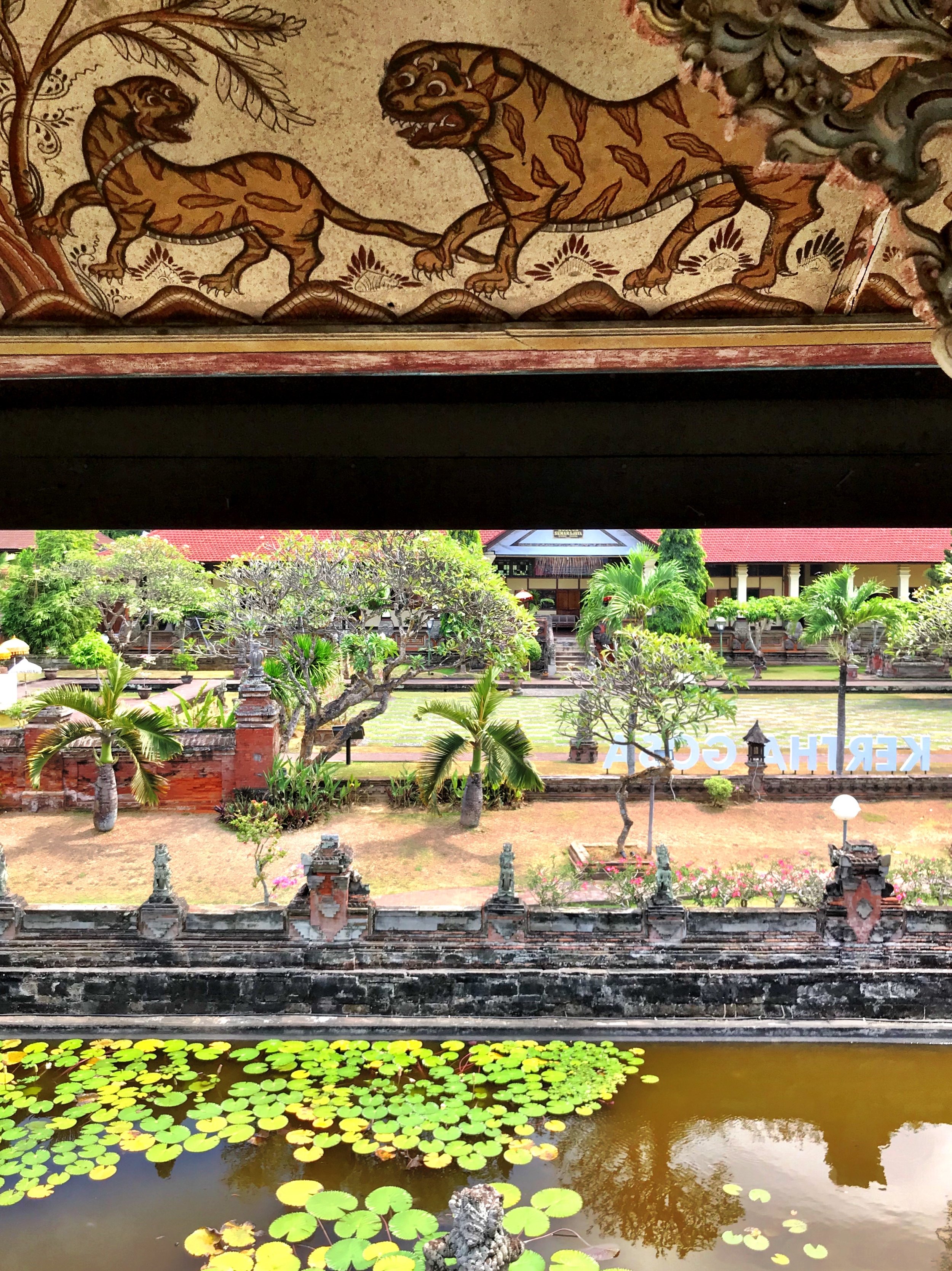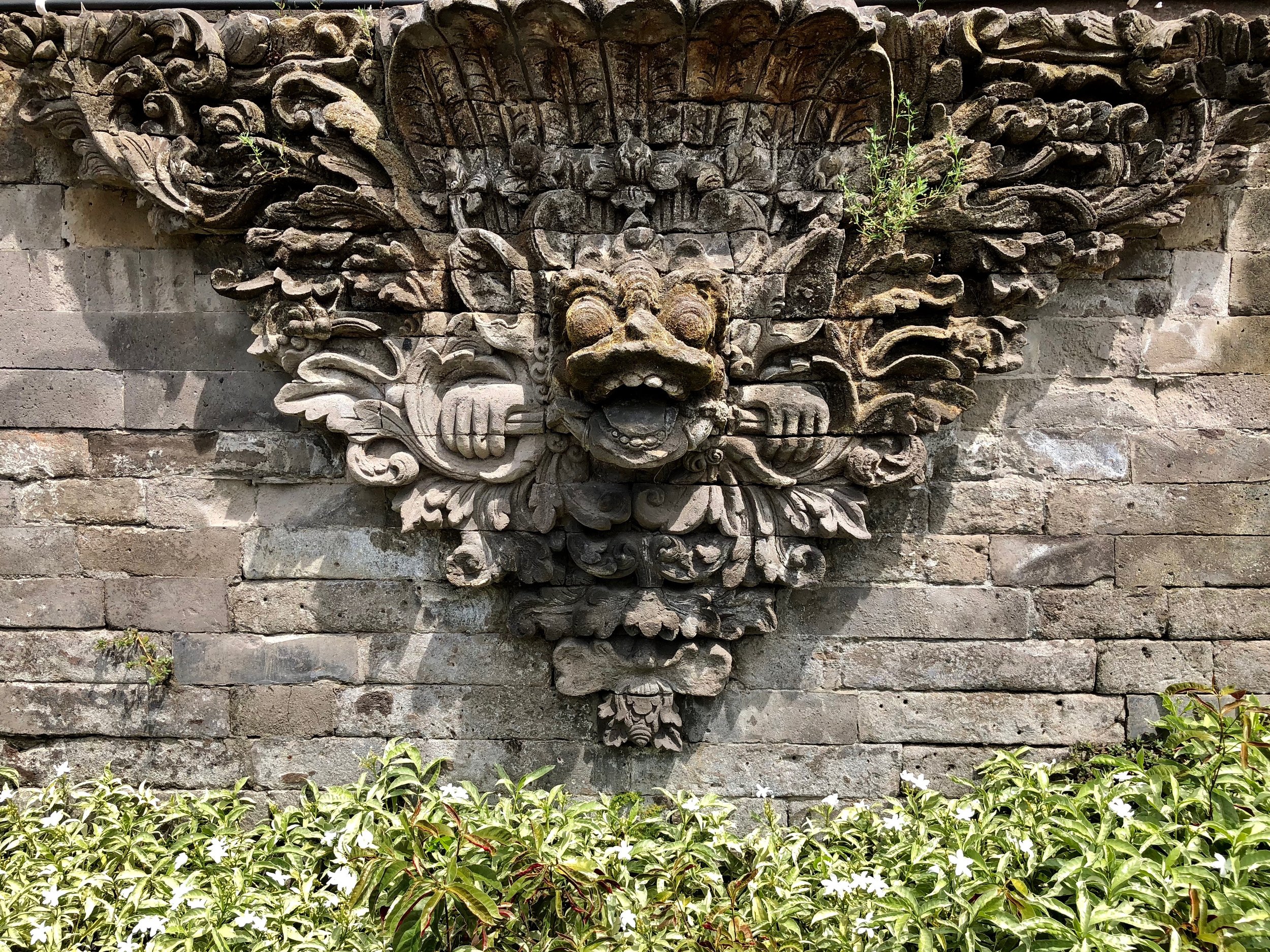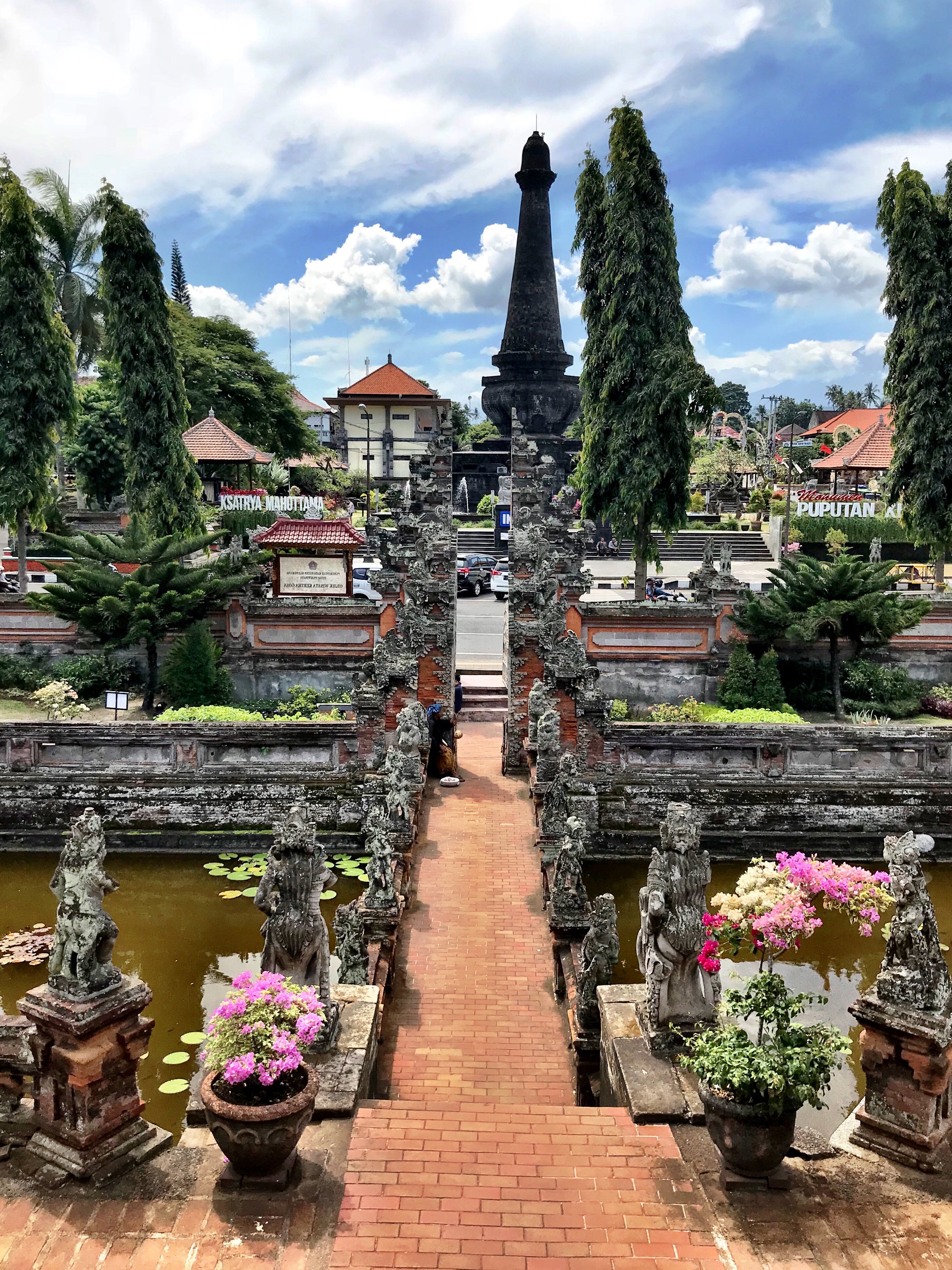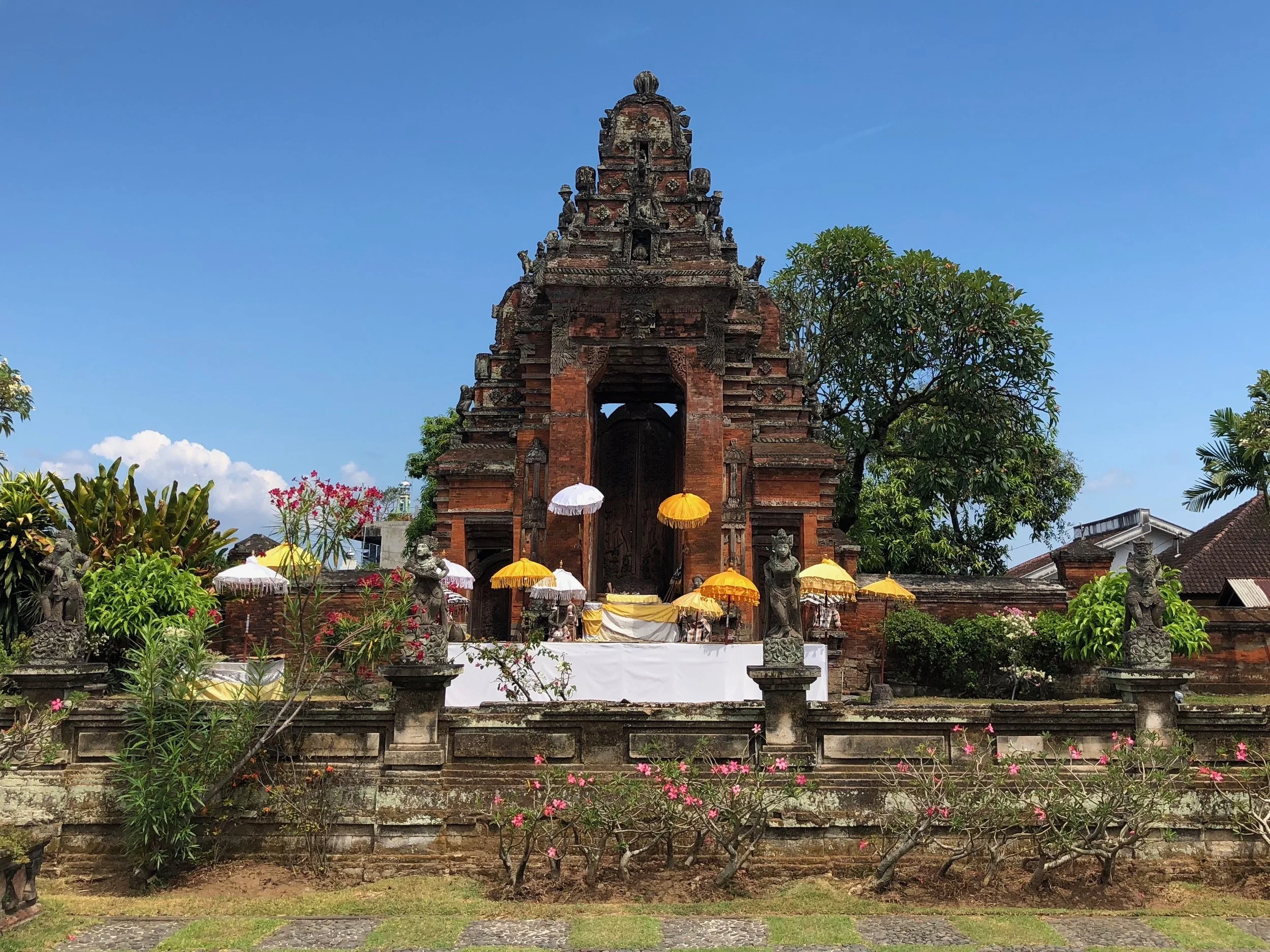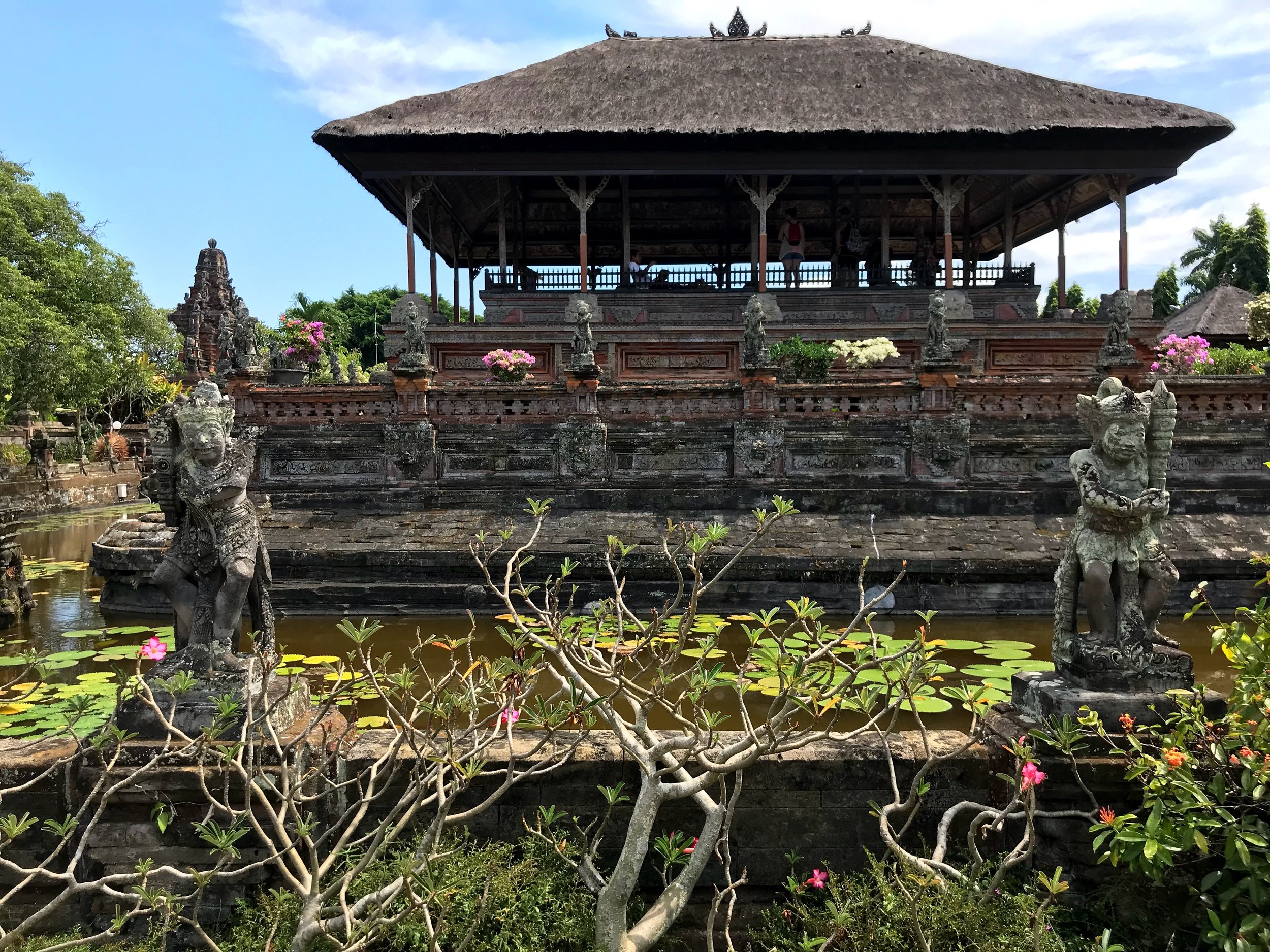Head to Semarapura to see a monument to a mass suicide and illustrated ceilings that depict gruesome demons.
Monstrous statues, lily-covered pools of water and pavilions filled with comic book-like artwork come together at Klungkung
A mythic creature watches over the pavilion
The Hall of Justice depicts various torments — like having your nether regions scorched
I had always been intrigued by one of the photos Wally had taken when he first visited Bali 17 years ago. The image is a detail shot of a small naked one-eyed male creature with a high ponytail.
I later discovered that he took this photo at the Klungkung Palace. This was my first time to Bali, but Wally’s second and I was truly excited to have found more than a few places he hadn’t been to. Klungkung wasn’t one of those places, but was so different from the other sites in our itinerary that we simply had to visit. Of course Wally didn't mind, which is one of the many reasons we make a great couple — we’re both drawn to the unusual and fantastic mythology of other cultures.
“The panels portray the various forms of hellish punishment awaiting those who are found guilty in the afterlife. ”
We arrived in Semarapura, the capital of the Klungkung Regency and purchased our tickets to enter across the busy thoroughfare from the pavilions.
If the Puputan monument looks like a giant phallus, that’s because it kinda is! This memorial is a linga-yoni, a representation of the Hindu god Shiva’s, er, divine energy
Overlooking the town’s main intersection is a towering memorial resembling an upside-down cannon barrel constructed of black volcanic stone. The monument is known as the Puputan Klungkung and commemorates the ceremonial mass ritual suicides known as puputan. The word comes from the Balinese puput, meaning “to finish” or “end.” And that’s exactly what occurred when the Dutch invaded Semarapura in 1908 and brought the entire island of Bali under colonial domination. Miniature dioramas inside the memorial depict scenes from historic local events, including the battles with the Dutch.
Two pavilions and a ceremonial gate are all that remain of a former palace in Semarapura
Klungkung Royal Palace
Across the street from the Puputan monument are what remains of the former royal palace complex of Puri Agung Semarapura. Built at the end of the 17th century, sadly many of its structures were destroyed during the Dutch conquest.
A brick path forms a bridge to access the Floating Pavilion
Wally and I entered the Klungkung grounds through a side gate where a group of three women, ready to pounce upon unsuspecting tourists, were attempting to sell a variety of clothing, from sarongs to short-sleeved men’s dress shirts. We politely told them we weren’t interested and walked to the restroom located on the opposite side of the complex. When we emerged, one of the women who had split from the group awaited us and followed us around, trying to sell us an extra-large men’s batik shirt. Honestly, it was a cool shirt and we would have bought it from her if she had the right size.
The Hall of Justice is literally covered with illustrated panels
Justice was once meted out from this table
The Kertha Gosa Hall of Justice: Fantastic Beasts and Where to Find Them
Among the few buildings that remain is the Kertha Gosa. Situated in the northeast corner of the compound, the raised pavilion served as the kingdom’s Hall of Justice. Inside sits a table and six elaborately carved wooden chairs. Painted in red and gold, the raja’s chair features the image of a lion, symbolizing his position as chief of court. A second has a cow image and was used by a Brahman priest who served as both lawyer and advisor to the raja. A third chair bearing a dragon, was for the secretary.
A lion, dragon and cow decorate the chairs in the Hall of Justice
Here, the raja met visiting dignitaries and presided over a court comprised of himself and three Brahman priests. Disputes that could not be reconciled at the village level were heard and mediated within the Kertha Gosa Pavilion.
Looking up, the vaulted ceiling is covered with highly detailed narrative stories painted on wood panels, many of which are popular tales from shadow puppet theater. Their traditional style of visual storytelling is known as Kamasan or Wayang painting and were produced by generations of artists from the nearby village of Kamasan, who served as artisans to the royal court.
The ceiling is covered with illustrations — it’s like a Balinese comic book about a trip to Hell
Highly detailed images of gods, humans and demons rendered in red, indigo, ochre and white are arranged to illustrate the coexistence of the natural and supernatural.
The main subject of the paintings is Bima, a strong warrior from the Mahabharata, who journeys to the underworld to save the souls of his parents. Scenes portrayed in these panels are associated with the various forms of hellish punishment awaiting those who are found guilty in the afterlife.
Klungkung consists of two main structures, but golly, they’re fun to visit
The Floating Pavilion of Bale Kembang
After gawking at the ceiling and taking numerous photos, Wally and I continued on to the Floating Pavilion of Bale Kembang. Surrounded by guardian statues, the structure rises from the middle of a pond in the center of the complex. The pavilion was greatly expanded by the Dutch in the 1940s and was originally a smaller, lower structure which served as the base for the raja’s guards.
One of the guardians of Klungkung. Too bad they couldn’t have saved the local kingdom from colonization by the Dutch
Lichen covers many of the statues on Bali, lending an ancient otherworldly air to them
One of the narratives within the Bale Kembang depicts episodes from the story of the Buddhist king Sutasoma, who defeated his enemies through passive resistance. Also portrayed is the rags-to-riches folktale of the humble Pen and Men Brayut and their 18 children, who through their tireless labor, no pun-intended, achieve wealth. Bordering these panels is the palindon, an earthquake calendar foretelling the indirect effects of divine power should seismic activity occur during the corresponding month.
Overwhelmed by the variety of demon and exotic fauna before me, I barely noticed the male and female artists seated on the floor of the pavilion who were putting the finishing touches on single-scene Kamasan paintings. The man was doing the drawing and the woman filling in the color with a small brush. Stacks of these paintings and hand-painted fans, for sale as souvenirs were placed nearby.
Two artists create Kamasan style paintings, fans and Balinese calendars
In a bit of a daze by what we had just seen (or perhaps it was just hunger and the heat), Wally and I left the Floating Pavilion. One of the aforementioned women we had passed upon entering the complex approached us, delicately extracting several hand-painted eggs from a white plastic bag. Our resistance worn down, we purchased a few as gifts, agreeing to keep one for ourselves. We were glad we did, as we now have a souvenir of our experience at this magical place. –Duke
Klungkung Royal Palace
Jalan Diponegoro
Semarapura Kangin
Central Semarapura
Klungkung Sub-District
Klungkung Regency
Bali 80761
Indonesia


